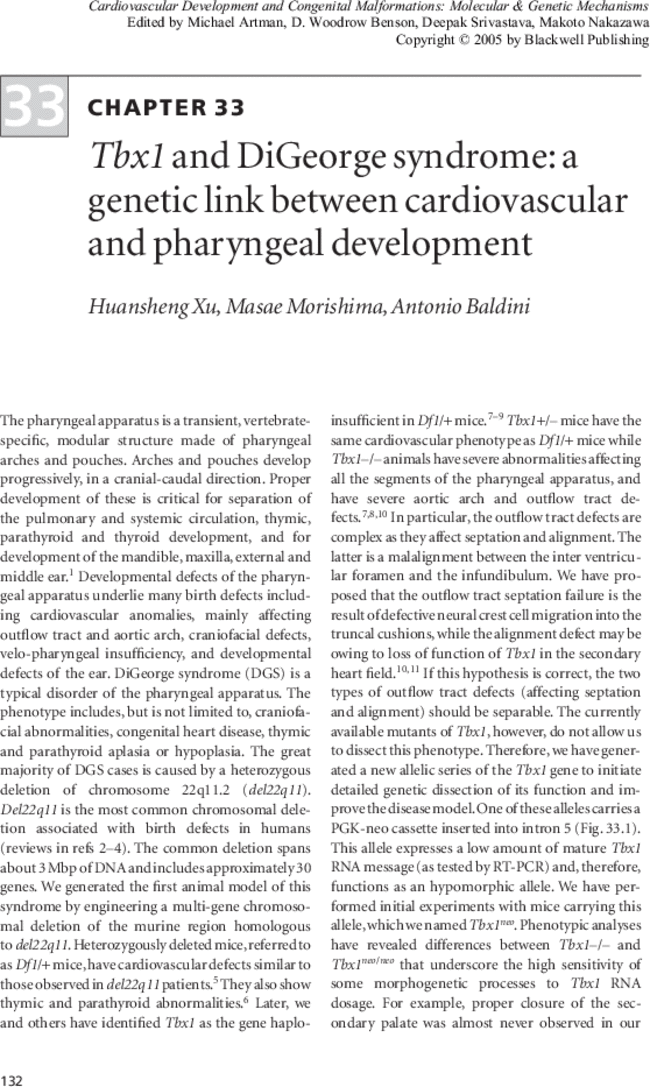Chapter 33
Tbx1 and Digeorge Syndrome: A Genetic Link between Cardiovascular and Pharyngeal Development
Huansheng Xu,
Masae Morishima,
Antonio Baldini,
Huansheng Xu
Search for more papers by this authorMasae Morishima
Search for more papers by this authorAntonio Baldini
Search for more papers by this authorHuansheng Xu,
Masae Morishima,
Antonio Baldini,
Huansheng Xu
Search for more papers by this authorMasae Morishima
Search for more papers by this authorAntonio Baldini
Search for more papers by this authorBook Editor(s):Michael Artman MD, D. Woodrow Benson MD, PhD,
Deepak Srivastava MD,
Makoto Nakazawa MD,
D. Woodrow Benson MD, PhD
Professor of Pediatrics, Director, Cardiovascular Genetics, Division of Cardiology, Cincinnati Children's Hospital Medical Center
Search for more papers by this authorDeepak Srivastava MD
Pogue Distinguished Chair in Research on Cardiac Birth Defects, Joel B. Steinberg, M.D. Chair in Pediatrics Professor, Departments of Pediatrics and Molecular Biology, University of Texas, Southwestern Medical Center at Dallas
Search for more papers by this authorMakoto Nakazawa MD
Professor and Head, Pediatric Cardiology, The Heart Institute of Japan, Tokyo Women's Medical University
Search for more papers by this authorFirst published: 01 January 2005

References
- Graham A. The development and evolution of the pharyngeal arches. J Anat 2001; 199: 133–41.
- Scambler PJ. The 22q11 deletion syndromes. Hum Mol Genet 2000; 9: 2421–6.
- Lindsay EA. Chromosomal microdeletions: dissecting del22q11 syndrome. Nat Rev Genet 2001; 2: 858–68.
- McDermid HE, Morrow BE. Genomic disorders on 22q11. Am J Hum Genet 2002; 70: 1077–88.
- Lindsay EA, et al. Congenital heart disease in mice deficient for the DiGeorge syndrome region. Nature 1999; 401: 379–83.
- Taddei I, Morishima M, Huynh T, Lindsay EA. Genetic factors are major determinants of phenotypic variability in a mouse model of the DiGeorge/del22q11 syndromes. Proc Natl Acad Sci USA 2001; 98: 11428–31.
- Lindsay EA, et al. Tbx1 haploinsufficieny in the DiGeorge syndrome region causes aortic arch defects in mice. Nature 2001; 410: 97–101.
- Jerome LA, Papaioannou VE. DiGeorge syndrome phenotype in mice mutant for the T-box gene, Tbx1. Nat Genet 2001; 27: 286–91.
- Merscher S, et al. TBX1 is responsible for cardiovascular defects in velocardiofacial/DiGeorge syndrome. Cell 2001; 104: 619–29.
- Vitelli F, Morishima M, Taddei I, Lindsay EA, Baldini A. Tbx1 mutation causes multiple cardiovascular defects and disrupts neural crest and cranial nerve migratory pathways. Hum Mol Genet 2002; 11: 915–22.
- Vitelli F, et al. A genetic link between Tbx1 and fibroblast growth factor signaling. Development 2002; 129: 4605–11.
- Momma K, Kondo C, Matsuoka R, Takao A. Cardiac anomalies associated with a chromosome 22q11 deletion in patients with conotruncal anomaly face syndrome. Am J Cardiol 1996; 78: 591–4.
- Marino B, Digilio MC, Toscano A, Giannott, A, Dallapic-cola B. Congenital heart defects in patients with DiGeorge/velocardiofacial syndrome and del22q11. Genet Couns 1999; 10: 25–33.
- Abu-Issa R, Smyth G, Smoak I, Yamamura K-I, Meyers EN. Fgf8 is required for pharyngeal arch development and cardiovascular patterning in the mouse. Development 2002; 129: 4613–25.
- Frank DU, et al. An Fgf8 mouse mutant phenocopies human 22q11 deletion syndrome. Development 2002; 129: 4591–603.
- Kochilas L, et al. The role of neural crest during cardiac development in a mouse model of DiGeorge syndrome. Dev Biol 2002; 251: 157–66.



